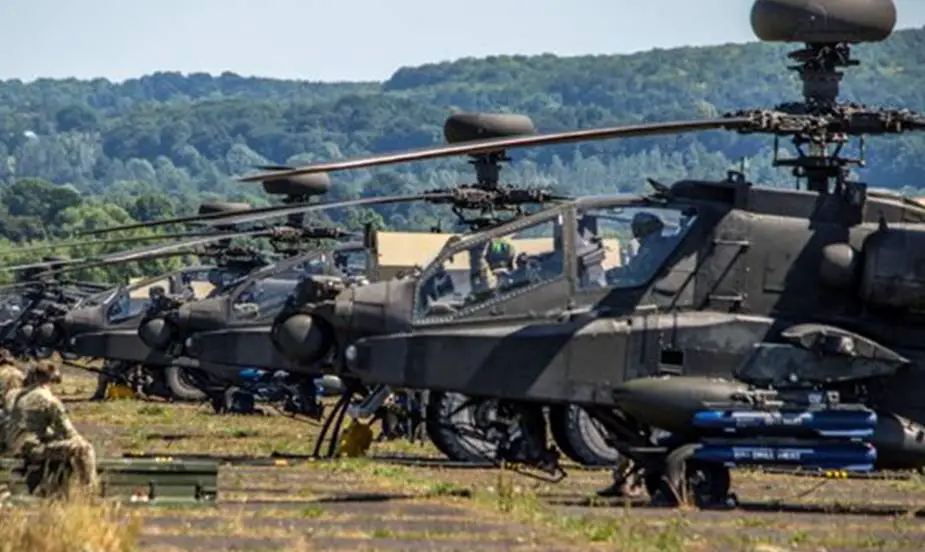A Royal United Services Institute (RUSI) paper has been published on the restructuring of combat aviation in the British Army. The report studied the new model of combat aviation within the Army, and the threats against aviation across the world, stating that combat aviation is a ‘unique capability within the British Army.’
Follow Air Recognition on Google News at this link
 The Global Response Force will be centred around an Air Manoeuvre Brigade Combat Team (BCT) and a newly established Combat Aviation BCT. It will be equipped with Chinook support, Wildcat reconnaissance, and new ‘E-model’ Apache attack helicopters (Picture source: British MoD)
The Global Response Force will be centred around an Air Manoeuvre Brigade Combat Team (BCT) and a newly established Combat Aviation BCT. It will be equipped with Chinook support, Wildcat reconnaissance, and new ‘E-model’ Apache attack helicopters (Picture source: British MoD)
As recalled on British MoD’s website, the 1 Aviation Brigade was launched in April 2020, bringing together all front-line army aviation units together under a 1* Headquarters. 1 Aviation Brigade now provides the Army with deployable and scalable aviation C2 at readiness, optimised for warfighting and capable of synchronising, coordinating and sustaining aviation operations.
This revised structure has created a fighting force more lethal and survivable than ever before. The Brigade is structured around four aviation task forces (ATFs). An ATF is the aviation equivalent of a battlegroup; they combine different aircraft types and their capabilities to produce greater effects and generate more flexible combat power. It said: Aviation can remain survivable and effective on the modern battlefield but must be able to use dedicated reconnaissance and intelligence to plan missions that bypass enemy defences and use terrain to approach targets undetected.
Another factor in favour of massing combat aviation is that it is able to independently inflict significant levels of attrition on adversary forces before they get into the close battle, thereby easing the pressure on close combat forces. This is a unique capability within the British Army.
The paper comes as Future Soldier was launched – the transformation plan for the British Army as a result of the Integrated Review. Future Soldier reorganised the Army structure around Brigade Combat Teams.
The Global Response Force will be centred around an Air Manoeuvre Brigade Combat Team (BCT) and a newly established Combat Aviation BCT. It will be equipped with Chinook support, Wildcat reconnaissance, and new ‘E-model’ Apache attack helicopters - with integrated strategic air transport from the RAF. This force will measure its global response time in hours and days, with the versatility to deliver humanitarian to warfighting crisis response.
More of the Army will be deployed across the globe more of the time, with the capabilities to operate alongside partners and compete with adversaries. We will be present in the places which matter most to the UK, meaning we can better anticipate events and reassure our allies.
The report concludes:
• With the formation of 1 Aviation Brigade, the British Army has made aviation critical to its warfighting capabilities, as well as to those of the joint force.
• The change in the threat environment produced by modernised adversary equipment and a return to great power competition makes a compelling argument for ensuring that aviation operations are executed with sufficient senior expert representation in joint planning and with dedicated command and control.
Brigade Commander of 1 Aviation Brigade, Brigadier Paul Tedman, said: “As this report says, massed combat aviation, and the ability to fight in the deep, is essential to how we will operate in future. Massed aviation operating in the deep was going to become crucial to the combined arms offer of the future. This formed the basis for the brigade. Subsequently, we tested the theory on exercises like Warfighter and Cerberus – and it was proven to be correct. We used attack and reconnaissance – so Apache and Wildcat. We routinely train together, along with the RAF. We now have two Aviation Task Forces – which have both attack and reconnaissance capability, as well as support elements; one at high readiness and one at very-high readiness. SDSR 2015 allowed us to re-orientate. The FS announcement now focuses on the operating side – in a global sense.”
The Royal United Services Institute report comes ahead of the RUSI Land Warfare Conference, the annual UK meeting of the British Army, its international partners and allies, and the Defence industry.
















